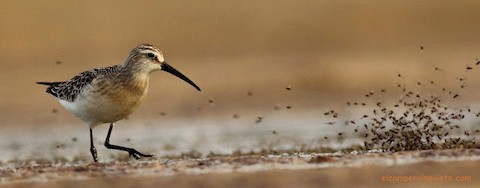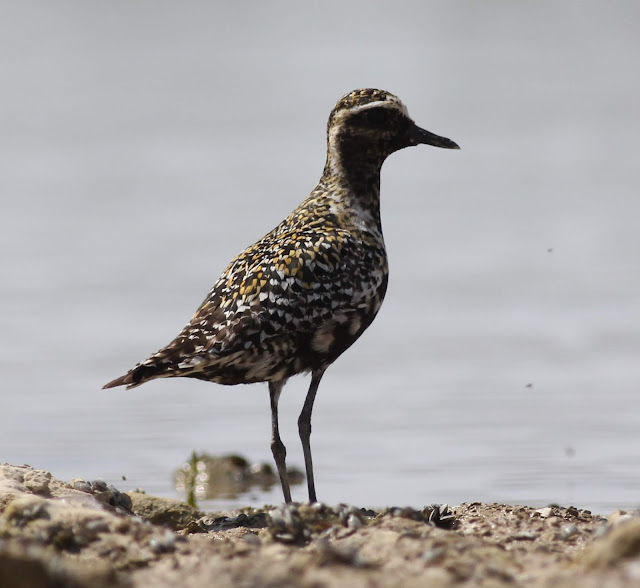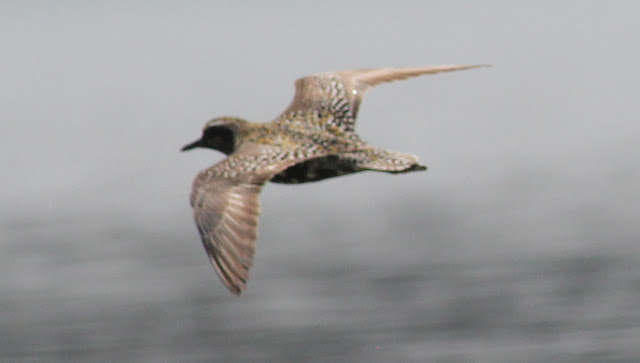Saludos camperos!!
I had yestarday (021218) a nice moment watching a sedimented group of common snipes (125 aprox) with as many lapwings in Figarol ricefields. With this mid tempered autumn, many waders are still lingering around. Yesterday temperatures reached 12 degrees! I suposse that numbers will drop down when freeze comes at nights.
Other waders that I could observe:
Golden plover (only one).
Green sandpiper (a dozen)
Ruffs (eight)
Dunlin (one).
Sadly birds were very nervous and the different groups flied away when we tried to observe them from a good distance with our telescopes. I went with my friend David.
Common snipe/Figarol ricefields/021218 from ornitocampero on Vimeo.
Three Dunlins

Monday 3 December 2018
Monday 26 November 2018
A good may day.
Saludos camperos!
Here is a small chronicle of a nice birding morning that I had in mid spring.
I was lucky enough to see some waders because in migration period the same area can be completely without a single bird.
Common sandpiper.
Only saw a pair of them that were lingering around some water ponds created by the recent rainfall.
Bar tailed godwit.
Very scarce bird inland. It keept feeding the whole time that I stayed in observation.
Very scarce bird inland. It keept feeding the whole time that I stayed in observation.
The most numerous species that morning, common redshanks and black headed gulls.
The mild tempered spring hasn't entered yet and the surrounding snowy mountains are present in the horizon.
The only avocet that I saw mobbed by a BHG.
Very elegant wader that is not normally seen alone.
A prenuptial ruff with its exquisite feathers.
The bird star of the morning ,a spring feathered knot!!
It was the only one I saw.
It was the only one I saw.
Is always a hard bird to encounter inland. Those ricefields are one of the best spots in Navarra to do so.
A group of ruffs "landing" in one of the different rice parcels.
Short stop and change of site. I saw a ringed bird buy I was unable of reading the color codes.
Thanks for reading and have a nice day!!!
Picture date;130518
Site;Arguedas ricefields.Navarra/Spain
And before leaving, let me recomend you an extraordinary brand of ecological rices (and other crops) that are harvested in the area were those waders find protection.
If those products are not consumed, it will not be long before this place becomes a "desert" of corn plants and a place without value for waders.
Some waders in Deltebre
Saludos camperos.
Last summer I took some spare time without my family while I was on vacation with them close to the Deltebre narural area to spend some hours birdwatching.
In general I could't find many waders due to the time of the year,mid of july, were most of them are still in their reproductive areas.
Young BWS inthe recently flooded rice field.
Solitary Oystercatcher in the tidal mudflats. Always a scarce bird in the area.
Common redshanks,kentish plovers and a turnstone that I didn't expect to see around at this time of the year around here. Probably it was back in its southern migration after not having a succesfull breading seasson.
One of the gems that breeds in the delta. Always a vulnerable bird if the colony sites are not respected by people that sometimes go with their untied dogs close to the dunes.
Youn pranticole in the beache's sand.
A pair of oystercatchers in the shoreline.
Those pictures were taken in july of 2018.
Thanks for reading the blog. Have a nice day!
Thursday 11 October 2018
Pluvialis fulva.
Saludos camperos!
At the end of august I could go for a twitch in Huesca a nearby county, in La Sotonera's damm were a Siberian golden plover was localized two days before in a concrete area in the northern shore.
This was the first record for the county and due to the not to long journey and that I was on holidays I decided to take the risk and set off with my equipment to the place.
When I arrived I saw the bird quite soon on the mentionned spot but due to the strong sun back light I could only recognize the bird, that was good enough (it was my main reasson). At thta moment I was alone and a few hours to try a better photo of this unique bird in the region ans a real raritie in Spain!
The pictures I took, show clearly the features of this Pluavilis fulva againts their closest relatives ,something not easy to apreciate and more with poor light or/and long distances.
Chorlito dorado siberiano (Pluvialis fulva).
Pluvialis fulva
The beak has a size between grey plover (bigger) and the american golden plover (more slender).
With those birds is interesting to gatter a few different characteristics in order to asses the species if there is not an evident diagnostic feature, easy to recognize.
With those birds is interesting to gatter a few different characteristics in order to asses the species if there is not an evident diagnostic feature, easy to recognize.
The terciaries have a less mottled pattern than the europeean.
The upright posture points out its long tibiae (apricaria has shorter ones).
Here with a prey item before it's swallowing.
As a plover it used the run/spot/peak technique all the time that lasted the sighting.
As a plover it used the run/spot/peak technique all the time that lasted the sighting.
Clear forehead and supercilium that isolates the well defined crown.
In this pic it's easy to see the absence of the posterior hind toe,they grey plover has a small one.
Rarely ventured far away from the water shore.
Sometimes other waders appeared in the scene,mainly green sandpipers and common sandpipers.
Typicall design of the nape and neck of the "golden plovers"......
The pointed wings surpass clearly the tail
The undertail covers with black and white spot feathering is another pointer for fulva.
The fulva's beak has a small bulging in the end of the upper mandible,the europeean doesn't have it and makes the beak more pointy (this is a very difficult characteristic to asses).
The fulva's beak has a small bulging in the end of the upper mandible,the europeean doesn't have it and makes the beak more pointy (this is a very difficult characteristic to asses).
The bird in flight shows very clearly the toe proyection beyond the tail, a characteristic that doesn't show in the europeean golden plover and the in the dominican can rarely appear, and if it does, not as obvious than the siberian one.
I saw it flying twice but I wasn't able to determinate the diagnostic pattern of the axiliar feathers (no white) in order to eliminate the grey plover with the obvious black spot.
In this case wasn't so valuable clue ,due to the good quality observations on the ground.
In both cases it emited its typicall call that remaind the greenshank's high pitched notes.
I saw it flying twice but I wasn't able to determinate the diagnostic pattern of the axiliar feathers (no white) in order to eliminate the grey plover with the obvious black spot.
In this case wasn't so valuable clue ,due to the good quality observations on the ground.
In both cases it emited its typicall call that remaind the greenshank's high pitched notes.
Winter grounds in blue with the reproductive area in yellow.
Momento Camel trophy.
Me
quede embarrado en las traicioneras orillas semi secas...menos mal que
había gente preparada que acudió al lugar y con 4x4, que me pudo sacar
con cinchas enganchadas a mi gancho...gracias!!
Con Jose Rovira y Pedro Rovira disfrutando del momento y hablando sobre aves e insectos..
Día
soleado (apenas había reverberación) y poquísimo viento, condiciones
buenas para la observación. Solo faltaba un poco de sombra.....
VIDEO-PLUVIALiS FULVA-250818
Saludos a todo@s.
Wednesday 10 October 2018
In the ricefields.
Saludos camperos!
My last day of holidays I set off to Argedas ricefields probably the best spot to observe wadders in the postnuptial period in Navarra. Sadly there werent many suitable fields with water that are the prefered ones for those birds in their migrational journeys. I saw a good number of species,twelve, and most of them in two parcels so the density of birds was big .
Temminck stint with two dunlins in the Zolina's reservoir at west coat (Zolina/030918).
By far the most numerous species that day, with a bunch of them lingering in the wet fields.
Temmincks stint.
The special bird of the day. Not easy to localize between the muds.
Nice pic comparisson between a Yellow wagtail and the Temmick stint.
Always surprisses the small size.
The common snipe is not easy to spot either due to the criptic colours that posses.
Common snipe.
Observation area.
Covered sky and not winds , perfect to stay a while.
Green sandpiper. In the beggining didn't see many but after a while a group moved and I saw a few.
Three greenshanks and a ruff.
A few wadders with a Heron.
One of the two Dunlins that I saw that day. This one is a juvenile.
By the way,here you have the chance to know and consume this extraordinary rice that is cultivated in Arguedas ricefields were the wadders rest. Neverdeless there is a big threat coming with the corn fields that slowly are advancing, taking more arable fields every year,something that doesn't help our birds obviously.
1 |
|
|---|---|
33 |
|
150 |
|
1 |
|
8 |
|
1 |
Lleva dos dias
|
2 |
Correlimos Común Calidris alpina |
60 |
Agachadiza Común Gallinago gallinago
Grandes grupos
|
1 |
|
45 |
|
3 |
|
3 |
|
45 |
|
5 |
|
1 |
|
1 |
|
11 |
|
7 |
|
1 |
|
1 |
|
3 |
|
5 |
Cogujada Común Galerida cristata |
5 |
|
20 |
|
1 |
|
1 |
|
2 |
|
3 |
|
80 |
|
8 |
|
175 |
Una thumbergii
|
5 |
|
2 |
|
3 |
|
50 |
|
15 |
Gorrión Común Passer domesticu |
Subscribe to:
Posts (Atom)


















































